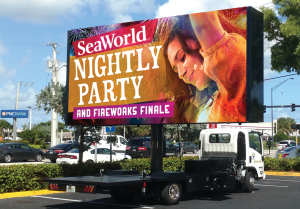The Mobile Billboards Cost: Why Broad Reach Misses the Mark
For years, marketers have been lured by the promise of high-visibility mobile billboards advertising. Trucks adorned with massive banners cruise through urban streets, claiming to deliver thousands of impressions per day. But what’s often left out of the conversation is the true mobile billboards cost—not just in dollars, but in lost precision, engagement, and effectiveness.
In today’s marketing landscape, relevance is everything. And while mobile billboard ads might appear flashy and omnipresent, they often fail to connect with specific, high-value audiences. In this blog, we’ll dissect the real cost of mobile billboards and compare it to the hyper-local precision of in-hand advertising strategies.
The Mobile Billboards Cost: More Than Just the Rental Fee
Let’s get real—the mobile billboards cost isn’t limited to the truck and the wrap. When brands opt for this format, they often incur hidden expenses like:
Driver wages and benefits
Vehicle maintenance and fuel
Permits for city driving or parking
Storage costs when the vehicle is not in use
Design and reprinting fees for campaign changes
And the kicker? These mobile billboard ads can’t guarantee who’s seeing them or for how long. Your message may roll through traffic jams or past empty streets. Even at their best, they rely on accidental visibility rather than intentional attention.
Targeting Woes: The Spray-and-Pray Problem of Mobile Billboards Ads
Marketers spend months crafting detailed audience personas—only to toss them out the window with a broad mobile billboards advertising campaign. Why?
Because mobile billboards offer limited audience segmentation. Sure, you can select a neighborhood or event, but you can’t control:
Who is actually present
Whether they see the ad
Whether they care about the message
That’s not targeting—that’s gambling.
And in a data-driven era, brands can’t afford to spray and pray. Consumers expect personalized, relevant messages, not generic promotions on the side of a truck.
In-Hand Ads: The Hyper-Local, High-Impact Alternative
Now contrast this with in-hand advertising—a form of hyper-local media that puts your brand into the literal hands of consumers, where attention is highest.
Imagine this:
A coffee sleeve ad reaching young professionals in boutique cafés near coworking hubs
A pharmacy bag ad targeting caregivers and health-conscious families
A pizza box ad delivered straight into dorms during finals week
Each of these options offers what mobile billboards can’t:
✅ Precision
✅ Relevance
✅ Physical engagement
✅ Memorable brand experiences
And the best part? In-hand media avoids the inflated mobile billboards cost while delivering real ROI.
The Mobile Billboards Cost vs. ROI of Hyper-Local Ads
Let’s break it down:
Metric |
Mobile Billboards Cost |
In-Hand Advertising Cost |
Average CPM |
$15–$30 |
$1.50–$4.00 |
Targeting Precision |
Low |
High |
Consumer Engagement |
Passive glance |
Active interaction |
Brand Recall |
Weak |
Strong |
Production Lead Time |
Long |
Short |
Campaign Agility |
Low |
High |
Clearly, the mobile billboards cost yields weaker results, especially when compared to cost-effective, targeted alternatives like in-hand media.
Real-World Example: Local Engagement Over Broad Reach
Let’s say a healthcare provider wants to promote flu shots. They could:
Option 1:
Wrap a truck and send it around the city for $15,000/month, hoping people read it in traffic.
Option 2:
Place ads on 10,000 pharmacy bags distributed at local drugstores for less than half that cost—reaching the exact people already thinking about health.
Which one would your CMO prefer?
Why Context Matters: Location Isn’t Enough Without Relevance
Mobile billboard ads might drive through a high-income zip code, but are they delivering a message at a moment of intent? Probably not.
In-hand ads appear:
During coffee breaks (ideal for B2B and tech brands)
At mealtimes (great for CPG and delivery services)
In waiting rooms or pharmacies (perfect for health and wellness products)
This contextual relevance gives hyper-local ads an edge. Your message isn’t just seen—it’s felt, held, and remembered.
Measuring Impact: Tracking That Goes Beyond Impressions
Mobile billboard providers often offer vague metrics—estimated impressions based on traffic patterns, not real engagement.
In contrast, in-hand advertising offers:
Distribution reports with zip code breakdowns
Redemption tracking via QR codes or promo codes
Dwell-time metrics (i.e., how long the consumer interacts with the item)
So not only is the mobile billboards cost higher—it’s less measurable. That’s a risky investment for modern marketers accountable to ROI.
When Might Mobile Billboard Ads Still Make Sense?
To be fair, mobile billboard ads can still have a role—particularly for:
Mass-awareness campaigns tied to major events
PR stunts or guerrilla tactics where shock factor matters
Markets with poor digital or physical media infrastructure






